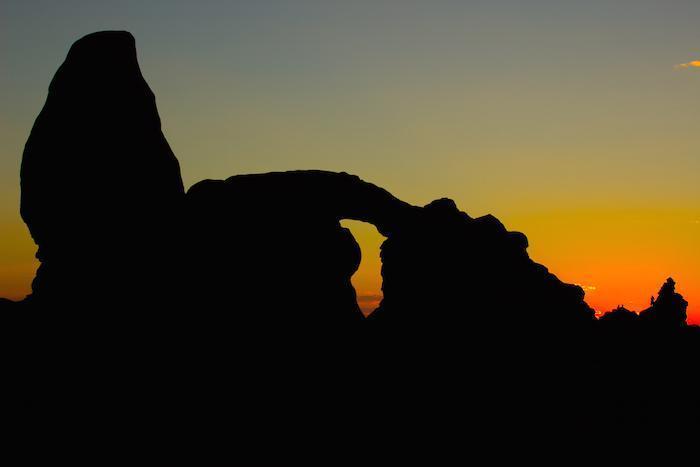
One of the most fantastic landscapes you'll explore is in Arches National Park/NPS, Kait Thomas
Arches National Park is one of the world's, not just one of the United States', most incredible national parks.
When you gaze at Balanced Rock, climb up into the Windows, or walk under Delicate Arch, it's hard to argue against that claim. The park's rock-itecture -- windows cut from stone, spindly arches longer than a football field, thin fins of rock -- and desertscape are otherworldly.
While Yellowstone National Park lays claim the world's largest collection of geothermal features, with some 10,000, Arches National Park holds the record for most nature-carved sandstone arches, with more than 2,000. Among them is Delicate Arch, which graces Utah license plates, and Landscape Arch, which somehow, despite its thin profile and 306-foot base-to-base span, continues to defy gravity.
Though blistering hot during the height of summer, Arches is a great stop in the fall and spring, and for those who don't mind winter's cold -- with little snow -- the solitude can be exquisite!
A park that those in a hurry can tour the highlights in half-a-day, Arches is much more rewarding to those who take the time to explore its nooks and crannies and savor its nuances. There are short, and long, hikes that cast this redrock desertscape in a variety of moods, a preserved log cabin built by a Civil War veteran to peer into, and Native American rock art that tells stories of earlier cultures that traipsed this redrock setting.
And here is where a chapter of American environmentalism was written, as the late Edward Abbey spent a season here as a ranger and worked on Desert Solitaire in a trailer not far from Balanced Rock.
The park is a gigantic playground for kids. It's rock outcrops are perfect for games of hide and seek, and there's even an official sandbox ... under, of course, Sand Dune Arch.
Traveler's Choice For: Families, kids, photography, hiking, geology
Traveler footnote: Be extremely careful with when you schedule your Arches National Park vacation. Moab hosts special events throughout the year, such as an antique car show and an "Easter Jeep Safari," and lodgings raise their nightly rates spectacularly. Check the DiscoverMoab website's calendar of events to ensure you won't run into conflicts. You also might find condo rentals work out to be less expensive than nightly motel stays.




 Support Essential Coverage of Essential Places
Support Essential Coverage of Essential Places







Comments
Hiked Delicate Arch trail twice seven years apart. Very crowded as it has received much pub. Reservations are being considered as a way for Patk Service to accommodate the demand. The arch itself is sublime.
we visited the Arches this summer and loved them
My husband and myself traveled around the world last month. We began in Charlotte flew to Dubai, United Arabian Emmerts and ended in Moab, Utah before flying back to Charlotte. From man-made skyscrapers to God made arches, Arches National Park was the best! Thank you for letting us visit your spectacular park!
We went in February and did all five parks. Delicate Arch was the biggest crowd we saw all week. If you want to get away from the crowds track Ysidro Valley Loop in Capitol Reef. It's one of the least traveled roads in North America. I've done it several times in February was the only time I've ever seen anyone. We encountered a gentleman on his way out early in the morning. Camped overnight.
Happy trails
In the last five years I've visiited Arches three times...twice in February and once in April. The snow contrasting with the red rocks and green foliage was wonderful, and the cooler temperatures made for some comfortable hiking.
April was a little busier than February, but crowds were never bad in those months. Never a had a problem parking anywhere. I'm always amazed seeing the reports of huge crowds and traffic backups in summer. No thanks.
I just visited Arches and Canyon lands for the first time and was overwhelmed by the beauty of the colored soil and rock formations. At the same time I was shocked at the intrusion of the foriegn imported grey granite used for the walking pathes in the park. The rocks migrate everywhere and and make the paths look dirty. The natural (primitive) paths were beautiful red, soft and quiet to walk on and the soil was clean even to the touch. On the granite trail each step would produce a grinding sound which disruped the Silence (which is part of the park experience) as I walked. The grinding of the granite gravel under foot produced a fine dust which blows over the beautiful red soil and made it look dusty grey and dirty. I began to see the grey dust every where the trails were and the grey piles of migrated granite gravel moved by rain and hiking boots all over the place.
I couldn't imagine that others aren't aware of the intrusion of this foriegn imported grey granite gravel agrigate and how it is poluting the Park. Any thoughts?
I suspect Tedson's 'foreign' trail tread is intentional, designed to add pyschological definition amd incentive to keep visitors on the designated path and reduce soil compaction, tread widening, and the formation of unsightly 'social trail' networks. He makes an interesting point, though.
In Rainier's Paradise area, even ten-foot wide paved trails are being trampled wider by the crowds. Resource Managers, who would be appalled by revegetating with exotic species, apparently aren't concerned about lining the trail edges with geologically exotic boulders to confine the traffic.
This rock lining would be much more effective if it were not so totally continuous that it prevents drainage, resulting in erosion of the (too small) imported pea gravel and forming large puddles that many people avoid by leaving the trail.